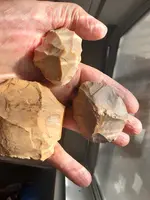From the perspective of 35+ years of studying exactly such stuff, to the near exclusion of "points" (Jack Webb voice: "Just the tools, Ma'am"):
People virtually disable themselves from understanding NA tools by focusing on "arrowheads" early on. Once the assumption is established that "arrowheads" (points) are real artifacts, then the rest of the lithic assemblage (except for no-brainers like endscrapers) must only be waste flakes, produced and discarded in the process of making bifacial points.
If they would only question their default assumption -- that they would have reduced a 2-3 pound nodule to one point, letting the rest go to waste, it might dawn on them that, unless they were at an outcropping of easily available chert, or a rich alluvial deposit of it, the idea underlying such profligate behavior is absurd : you don't waste what you need to survive (!) (Not to mention that points have very few uses, while flakes have many).
The Paleoindians in particular, but all NAs in general, had well-developed strategies for making good use of everything (or at least producing pieces that could be turned to good account -- 8n the case of the PIs, often several possible ones, the choice depending on the need of the moment). Imagining otherwise is the lithic analogue of assuming that they only ate the steaks and roasts, letting the dogs have the rest of the animals they harvested. It also depends on ignoring the evidence to the contrary in front of their faces.
In point of fact, the flake (the "waste flake"/"debitage" of the arrowhead hunter) was the single most useful (and used) item in the lithic assemblage -- evidence of which you're noticing and bringing to attention.
The sharpest, razorblade-like edge you can produce is the un-altered edge of a flake, just as it comes off the interior of a core. Archaeological replicators have skinned and butchered entire buffalos with single flakes, without creating use-wear in the process. Other times, other uses have left evidence of use on their working edges (as on some of yours) and, in still others, the edges have been refreshed by flaking, proving intentional creation/use beyond argument, without needing recourse to an electron microscope.
Further : in light of this people can (once they pull their heads out of the "arrowhead" obsession) grasp the significance of the many flake cores they find (and generally discard unless they're in Ohio and finding pretty colored ones of baked Flintridge). Previous to pocket knives and pants pockets to carry them in, people out & about carried such cores with them, engineered so that the next good flake removal was set up somewhere on the edge configuration. Need a fresh, sharp edge ? Just punch one off.
Once people stop assuming they know it all and start paying attention to actual relics, as you're doing, all kinds of neat, new information starts getting noticed and processed into a more accurate impression of life in the past.
Pictures follow, if I can manage them.












